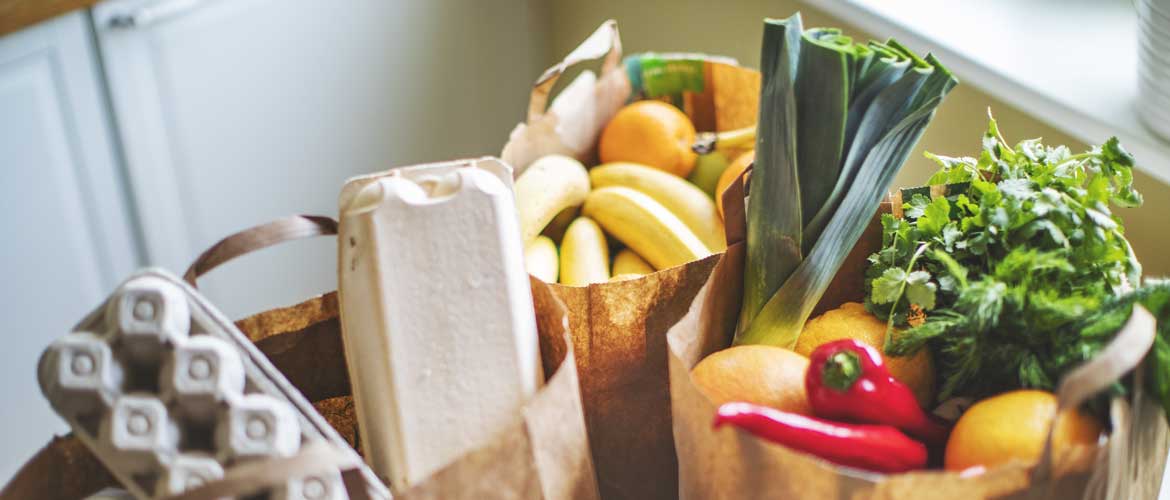November 2, 2020
The world of wellness has become a bit harder to navigate in recent years, with fads and trends popping up from everywhere - and being recommended by everyone. We’ve talked to MedExpress team member and nutritionist Lindsay Nelson to get the inside scoop on healthy swaps, what foods make a good meal, and if those trendy diets are really good for you. Before changing your diet, though, remember to talk to your doctor first.
Simple Food Swaps Can Make Average Foods Healthy

Let’s be honest: chips with warm, gooey queso might sound better than chips with fresh pico de gallo. But when it comes to eating healthy, we all know the better option. “Anything that’s refined or processed, or high in added sugars –you would want to swap for whole foods. For example, swap white breads for whole wheat, pastries for fruit, soda for lemon water or seltzers, and chips for nuts,” says Nelson.
And healthy eating still means enjoying foods you love. For example, spaghetti with meatballs isn’t a particularly healthy meal, but making swaps like whole grain spaghetti with fresh tomatoes, spinach, and chicken meatballs is an easy dupe that cuts out processed pasta sauce, adds veggies, and reduces the overall fat.
Here are some other easy tips that can help make an ordinary meal into a healthier choice:
- Don’t assume organic equals healthy. While an organic product might be marketed to sound healthy, if the ingredient list is still long and complicated, chances are it’s not much better for you than the processed item the next aisle over. Always read ingredient labels and check nutrition facts before buying a product– you might be surprised at which foods are actually better for you. Some easy rules to follow are to look for ingredients that you can pronounce, and aim for processed foods with five ingredients or less.
- Use brown rice and whole grain pasta instead of refined grains. Not only do they add fiber, but whole grains help you stay full longer, meaning you’re less likely to snack in between meals.
- Use olive oil in place of butter when sautéing foods. Olive oil contains more healthy fats, like polyunsaturated and monounsaturated fats and no cholesterol. If you can’t do without the buttery flavor, opt for grass-fed butter, which contains more Vitamin K2 and omega-3 fatty acids than regular butter.
- Swap out salty, fatty snacks like cheese curls, potato chips and buttery crackers for lightly buttered popcorn. Popcorn is 100% whole grain and offers a modest 80 calories per cup. Just be sure to reach for a low-calorie option instead of traditional butter flavors, which still pack lots of salt and fat.
Balanced Diets Are Always Best for You
Building a great meal starts with the right foundation. Nelson explains, “Everyone has their own individual dietary needs, but in general, a diet high in fruit, veggies, and whole grains is optimal. When you look at your macro calorie breakdown for the day, you want it to be within the following ranges: carbs 45-65%, fats 20-35%, and protein 10-35%.” Macronutrients are the main sources of calories in a standard diet, including carbs, proteins, and fats that your body needs to properly function. Most people follow a 2,000-calorie diet, which means those percentages can be broken down in the following ways:
- 900-1300 calories are from carbs
- 400-700 calories are from fat
- 200-700 calories are from protein
Here are some ways to make your meals come together:
Main dishes
When preparing your menu, you always want your main dish to shine – and making it healthy can help! As much as possible, you’ll want to use fewer processed foods and more whole grain alternatives. If you’re looking to keep carbs low, zucchini noodles and riced cauliflower are similar alternatives that are also better for you.
If you eat meat, look for antibiotic, hormone and grain-free options to ensure high quality and minimal processing. If you’re meat-free, opt for beans, legumes, tofu, tempeh, and whole grains like quinoa, bulgur or farro to add protein to meals. Although frozen veggie burgers and similar meat dupes are high in protein, they’re also quite salty and processed.
When it comes time to season your dishes, go easy on the salt, and rely instead on other herbs and spices to bring out the flavor. It always helps to go easy when adding sauces and cheese, too – they can quickly add a lot of extra salt, fat and sugar.
Sides
Side dishes can help wow dinner guests and show off your culinary skills. Try incorporating at least one fruit and one vegetable per meal, preferably fresh, in-season picks. A fresh fruit salad or side salad is a great way to add some color to your plate. If you prefer cooked vegetables, try steaming or baking, which typically add less fat than stir-frying or sautéing. To add fruit in dishes, try fun combinations like adding fresh mango to salsa, apples to chicken salad, or pears to a homemade goat cheese pizza.
Beverages
One of the most overlooked areas of mealtime is what you’re drinking with your meal. While the occasional glass of milk or juice doesn’t hurt, it’s always best to pair the meal with the simplest of beverages: water. While it might not offer much in the way of taste, water hydrates your body and saves you around 120 calories every meal when it’s swapped for milk or juice. Skipping that sugary soda for a water saves even more empty calories – not to mention a ton of added sugar!
Choose Filling Foods to Fuel Your Body Properly
It’s 3 o'clock and your stomach is rumbling away for some sweet treats and salty snacks. While you could just be in the mood for junk food, it could also be that the foods you eat regularly just aren’t that filling. Many of our favorite foods like pizza, burgers, pasta, and tacos might taste great, but they often offer little in the way of nutrition. These foods are commonly known as empty calorie foods.
Nelson explains that, “Junk food or empty calorie foods are highly processed, refined foods that are high in sugar, fat, and salt (just the right amount of each to keep us craving more). These foods don’t provide any nutritional benefit and won’t fill you up, so you will likely end up over eating.”
One fun way is to take a favorite dish and brainstorm ways to make it better. Instead of microwaving a frozen mini pizza for lunch, try making your own using mini whole grain pizza crusts, fresh tomatoes, and topping it with leafy greens like spinach. Nelson also suggests incorporating calorie-dense foods like fruits, vegetables, nuts, seeds and whole grains: “These foods are high in fiber and overall nutrients so they will provide you what you need to stay full.”
Food Can Affect Your Mood

Similar to how exercising releases endorphins or a tense thriller can get our adrenaline pumping, food also can affect our biological responses. One popular example is how eating chocolate releases endorphins, making it a true comfort food – both to our stomachs and our bodies!
“Micronutrients (vitamins and minerals) play an important role in specific biochemical reactions in the body, so a lack of these nutrients can affect mental health and overall body functions,” Nelson explains. For example, studies have found that diets rich in vegetables, fruit, and whole grains, such as the Mediterranean diet, can help improve cognitive functions and depression.1 While there’s still more research to be done, eating your leafy greens certainly can’t hurt! Another important factor in feeling good is gut health, which affects nutrient absorption. Nelson explains that, “Fermented foods help to contribute to a healthy gut, which in turn helps to properly digest and absorb nutrients for overall better cognitive functions.” Try incorporating a variety of fermented foods like yogurt, kombucha, and miso soup in your weekly line-up to help keep your gut feeling great.
Superfoods Can Sometimes be Misnomers
While we’re all familiar with so-called superfoods, like goji berries, avocado, and chia seeds, what we may not realize is that while they might be good for you, the name is a bit misleading. “Superfood is more of a marketing term, which means it can be subjectively applied,” Nelson said. This means that while superfoods are good for you, plenty of other foods are too, though they might not be labelled as such.
Chia seeds, in fact, are a great example as to why superfoods may not be an everyday option. While they contain high amounts of healthy fat, fiber, and magnesium, they’re also quite calorie dense: a serving size of two tablespoons contains about 140 calories, causing calories to add up quickly, especially if you aren’t paying attention to how many you eat.
Be Careful of Trendy Diets That Cut Out Foods
While popular diets offer promises of better health, weight loss, and a general sense of feeling better if we simply cut out certain foods, they’re not always sustainable. And there’s a good reason behind it; it’s hard for severely limited diets to supply your body with all the nutrients and energy it needs for a long day ahead. As Nelson explains, “Everybody’s nutrient needs are different, so it’s hard to say which diets work best. But selective diets that cut out entire food groups, like a fat-free or no carb diet, are not sustainable and shouldn’t be a long-term solution.”
Even though you may look and feel better when you only drink your calories from smoothies or eliminate oil and fats when cooking, cutting out food groups is a bad practice because our bodies rely on calories that come from a variety of sources and supply different vitamins and minerals. Cutting out all fat, for example, can lead to brittle hair and nails, while liquid diets can often lead to low protein.
However, there are some exceptions to the rule: “Food allergies and sensitivities that require people to be ‘gluten free,’ for example, would be the only exceptions because they can cause major digestive issues that lead to malabsorption issues, which affect overall bodily health,” Nelson states. Her tip for dieting? “Diets that don’t cut out major foods groups and focus on eating whole foods, mostly plant-based, are the best.”
While there are no one-size fits all nutrition plans, there are some general steps to make the most of your culinary creations and fuel your body with tasty – and healthy – foods.
References:
1 Annals of Neurology: Mediterranean Diet, Stroke, Cognitive Impairment, And Depression: A Meta-Analysis. Updated October 2013. Accessed September 9, 2020.
